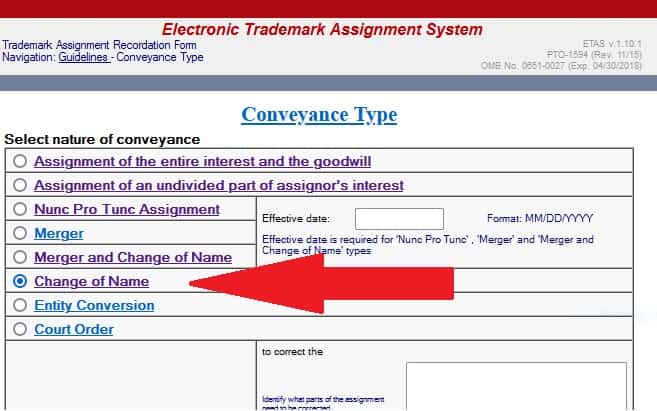Changing the Applicant Name in a Trademark Application
In the past year, I have dealt with one issue more times than I have in the previous ten years of practice: correcting or changing the applicant name in a trademark application during prosecution. Apparently trademark applicants are mis-identifying themselves more and more frequently in trademark applications than they used to.
Changing a trademark application after it is filed can be difficult. Some changes are relatively simple. But changing or correcting a trademark applicant’s name is not always a straightforward or safe thing. The reason for the correction dictates whether it can be made at all. Some changes are simple, some are complicated, and some will potentially invalidate the trademark application.
Different Types of Changes
A change of the trademark applicant name may need to be made if any of the following have occurred:
- Trademark owner changed its name without a transfer of assets
- Transfer of ownership of the trademark
- The owner was identified incorrectly in the original trademark application filing
- The trademark owner died
Trademark Filing Basis Can Limit the Change
The law limits the extent to which a trademark applicant can change an owner’s name on an intent-to-use trademark application. You generally cannot assign an intent-to-use trademark application to a third-party.
Any name changes of intent-to-use applications must reflect only changes of ownership to a business successor for the goods and services connected to the trademark. Otherwise, you must wait until the trademark application’s filing basis changes to “in-use,” such as after filing an Amendment to Allege Use or a Statement of Use.
Entity Name Change
Sometimes, a company changes its name without merging or selling. When the company simply undergoes a name change, then updating the applicant name in the trademark application is fairly easy. Go to the Electronic Trademark Assignment System (ETAS) and then select “Change of Name”:

You may also need to change the entity name if the owner was a person and changed his or her last name. For instance, if the owner got married and adopted a new last name, she could change her name in this way.
Transfer of Ownership
If the trademark has changed hands, then you should record a transfer of ownership or a trademark assignment. Typically, this will happen when one company buys a product line or another company.
The Trademark Office requires submission of the document effecting the transfer of ownership. This document will become public record. For this reason, big agreements sometimes include a separate trademark assignment as an exhibit to the agreement. This allows the attorneys to file only the exhibit without revealing all the details of the big agreement.
Correcting a Mis-Identified Applicant
When a trademark application initially identifies the wrong applicant, real problems can arise. Changing the applicant name in a trademark application like this has to be done with extreme caution. It can result in the invalidation of the application.
First, a trademark application must always identify the owner of the trademark as the applicant. When an application is filed in the name of the wrong party, this defect cannot be cured by amendment or assignment. The application is then void and invalid.
If there was a mistake in identifying when the applicant’s name was entered, then this might be correctable. There are only a few situations in which this correction can be made:
- If the trademark owner provided its trade name, or its dba, but that name is not actually its legal name, then the Trademark Office does permit a correction. You can fix the application to change the applicant name from the dba to the entity’s actual legal name.
- If the application identified a division of the company, rather than the company itself, this mistake can be corrected.
- If you forgot to put something minor like “The” or “Inc.” then in most cases this mistake can be corrected. The Trademark Office will not tolerate any change more significant, however.
- If there is an internal inconsistency in identifying the owner, then the Office will permit correction of the applicant name. For example, in some places, you may have listed the owner as a company and in other places as an individual; the Office will let you correct this to make all references to the owner consistent.
- If the owner changed its name before filing the application and used the old name on the application, then the owner may correct the applicant name to the new name. You may be required to explain that the previous name and current name identify the same enterprise.
- Identifying partners in a partnership, rather than the partnership itself, can be corrected.
Specific Situations that Cannot be Fixed:
- Trademark applications that identify an employee of a company as the owner, rather than the company itself, cannot be corrected.
- If the trademark application identifies a first company as the trademark owner, but prior to the filing date of the trademark application, that first company had actually already transferred the trademark to a second company, then the trademark application is void.
- If a trademark is owned by a joint venture, but the application only names one of the joint venturers, then the application is void.
- If the trademark application identifies a related company which is not the owner, then the trademark application is void. For instance, if a sister company owns the trademark application, or if a subsidiary company owns the application.
